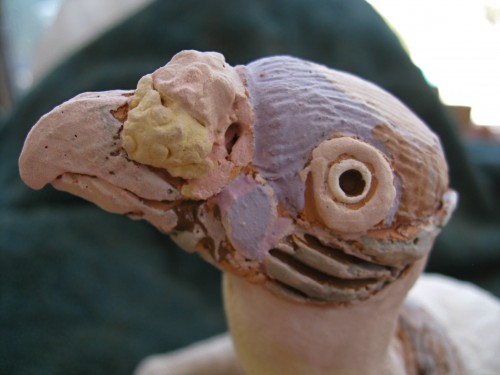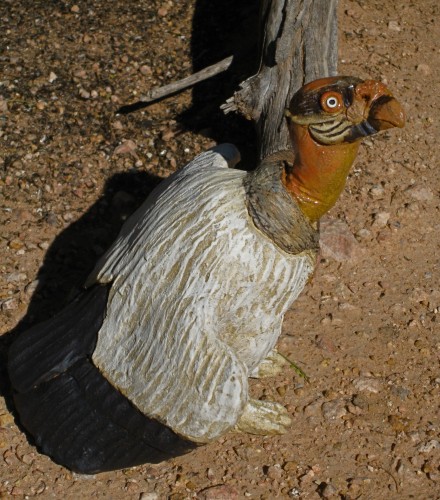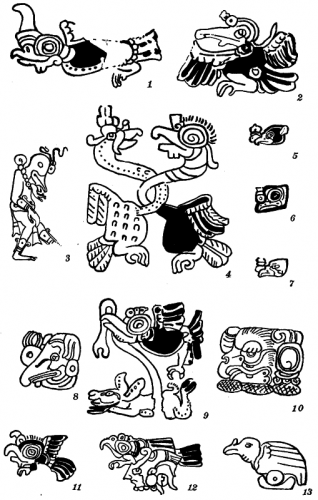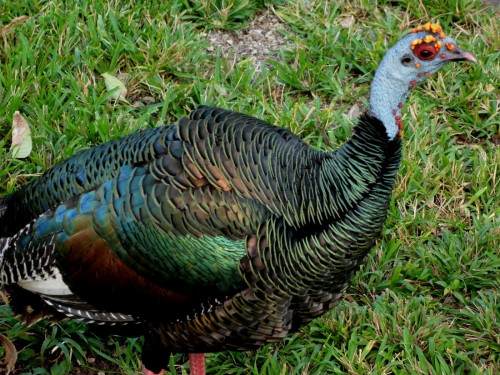Increments: Color me vulture, finally
Here are the exciting final steps of Jack’s King Vulture. (Previous increments can be viewed and read about here.)
This first photo, Increment 3, is a close-up of what the piece looks like after it’s been bisqued (fired the first time) and then glazed. Pretty crappy looking, isn’t it? That’s because glaze is a chalky-looking liquid suspension made of clay, mineral pigments and oxides, a flux or glassy component to create various levels of gloss after melting, plus water. If Pepto Bismol came in a lot of different icky-pale flavors, they would look like glazes. Because of this, glazing a piece you’ve already spent hours on can be an act of faith, and once the raw glazes are on, it’s often hard to escape the feeling that now you’ve gone and ruined it, which sometimes you have. Fortunately the more you glaze, the better able you are to predict what the chalky colors will look like after firing, so the more you trust the materials and the process (=faith, for a potter). It’s only after the final firing that the glaze colors take on any kind of brightness and glassy quality. Here is Increment 4, Jack’s finished King Vulture, Sarcoramphus papa, photographed in the wilds of Scottsdale:
Pretty crappy looking, isn’t it? That’s because glaze is a chalky-looking liquid suspension made of clay, mineral pigments and oxides, a flux or glassy component to create various levels of gloss after melting, plus water. If Pepto Bismol came in a lot of different icky-pale flavors, they would look like glazes. Because of this, glazing a piece you’ve already spent hours on can be an act of faith, and once the raw glazes are on, it’s often hard to escape the feeling that now you’ve gone and ruined it, which sometimes you have. Fortunately the more you glaze, the better able you are to predict what the chalky colors will look like after firing, so the more you trust the materials and the process (=faith, for a potter). It’s only after the final firing that the glaze colors take on any kind of brightness and glassy quality. Here is Increment 4, Jack’s finished King Vulture, Sarcoramphus papa, photographed in the wilds of Scottsdale:
Check out the pale eye, it’s not a mistake: the King Vulture’s iris is white, which to our eyes looks pretty weird. In Mayan glyphs King Vultures are readily identifiable not only by the fleshy knob or caruncle atop their strong, hooked beak, but also by the bold concentric depiction of the staring white eye. Below is a plate from Animal Figures in the Maya Codices by A.M. Tozzer and G.M. Allen (1910) that shows a selection of Mayan King Vulture glyphs. Of course, I’m not an expert, but Tozzer and Allen report that the King Vulture represents Cib, the 13th day of the month. And, on an ornithological note, figure 4 in the plate below shows a King Vulture entwining necks with an Ocellated turkey, the turkey of the Maya, which puts our Wild Turkey of North America to shame in terms of colorful plumage and warty wattly facial skin, which is saying something. I photographed the Ocellated turkey below at Chan Chich in Belize, where they inhabit the immediate area along with King Vultures, like the one in a previous post who tried to hide behind a leaf.
 By the way, if you live in the Phoenix area, there are two King Vultures on display in a large aviary at the Phoenix Zoo. You could drop in any time to visit them. E and I just did, on Valentine’s Day. I guess we missed Cib by one day!
By the way, if you live in the Phoenix area, there are two King Vultures on display in a large aviary at the Phoenix Zoo. You could drop in any time to visit them. E and I just did, on Valentine’s Day. I guess we missed Cib by one day!

[…] could argue that the King Vulture, also a New World vulture, is even more colorful, especially taking into account its snowy […]